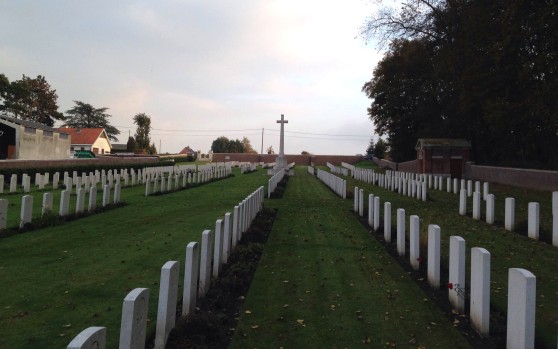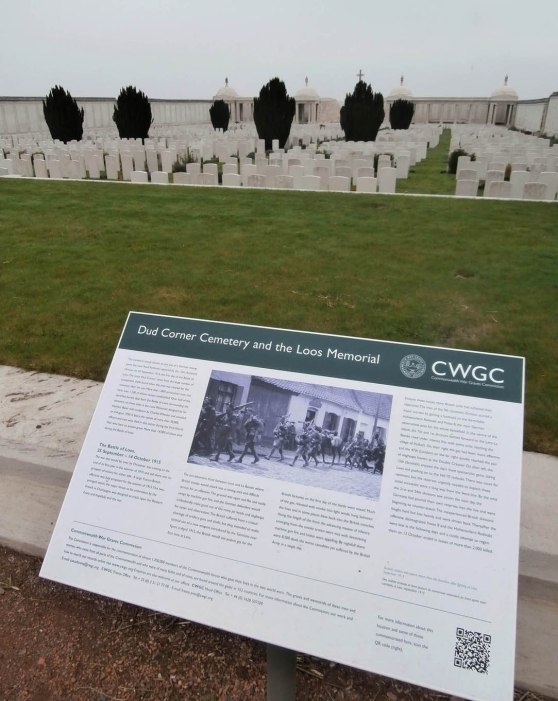




Its not unusual for First World War soldiers to have served under a name that wasn’t their own. One who I researched extensively a few years ago was a shipyard worker from Sunderland called Robert Hope, who for whatever reason, chose to join the Royal Inniskilling Fusiliers using his Gran’s maiden name, Hepple. The first example we have encountered amongst the Summerstown182 is someone we hold very dear and we are very grateful to a living relative who has shed some light on his story. On our memorial and the database of the Commonwealth War Graves Commission, his name is Charles Barnes, but the boy we remember in Summerstown is twenty year old Charlie Corben. Making contact with his niece set this project alight a few years ago. Of course, I thought something similar might happen every week and it hasn’t. To meet someone just one generation removed from those on our memorial was quite extraordinary. On top of that, Frances provided a stunning photograph of her uncle and showed us some of his personal effects. But perhaps, most memorably of all, she provided a memory of him which sends tingles down my spine whenever I think of it. It happened over one hundred years ago but it is still recalled on Alston Road today.


The words were provided by Charlie’s sister and created an extraordinary impression of the family’s final recollection of the young soldier. ‘The last thing she remembered was the sound of his spurs jangling on the pavement’. I could analyse those words all day. It evokes so much, a young man returning to duty, perhaps leaving home for the first and last time. An early morning farewell to the family home were he had grown up. The words ‘jangling’ and ‘spurs’ lending a heroic, almost Shakespearean edge to it all. The pavement would of course have been that outside No8 Alston Road, turn left for Tooting, right for Smallwood Road. Our impression of Charlie, fresh-faced and looking a little anxious in his photo, sitting awkwardly in an ornately carved wooden chair, coupled with the words of his sister, have put him very much to the forefront of this project. His name and photo have been shown on many of our Summerstown182 Walks as we pass his home on our way down Alston Road.


Charles joined the Oxfordshire and Buckinghamshire Light Infantry and his medal card indicates that he landed in France on 1st October 1915. He would have just missed the decimation of his regiment at Bellewaarde Farm, but was thrown into the Battle of Loos. He was killed on 1st January 1916 and its very unlikely that he got any leave in the interim period. Therefore, we can be fairly sure those spurs of his jangled on the pavement at the end of the summer of 1915 when he was swept up in the great Kitchener recruitment drive with Alfred Quenzer, the Baseley Brothers, William Warman and so many other lads who lived just a few doors away from him.


The 5th (Service) Battalion, Oxfordshire and Buckinghamshire Light Infantry was raised at Oxford in August 1914 as part of Kitchener’s First New Army and landed in Boulogne on 21st May 1915. At Hooge, they were the first division to be attacked by flamethrowers and in September suffered horrendous losses at Bellewaarde Farm, a disastrous diversionary attack in the Battle of Loos just prior to Charlie’s arrival in France. After this the war diary notes the loss of 52 dead, 246 wounded, 136 missing. Two days later a draft of 200 NCOs and men arrived as replacements, apparently ‘a very good looking lot of men’. One of these would have been Charlie Corben. Over the next few months they were in and out of the trenches around Ypres. There was occasional sniping and shelling, they trained, prepared for gas attacks and spent some relaxation time in Poperinghe. On New Year’s Eve the diary notes a move from Herzeele to St Jean ‘Quiet day. Barnsley Road slightly shelled. I other rank killed, 2 other ranks wounded’. On New Year’s Day ‘Quiet day. Half battalion in trenches relieved by half battalion in farms. Work on trenches and supports, 3 ORs killed, 5 wounded’. One of those three was Charles Corben. The others were 18 year old Frederick Twist from Birmingham and 19 year old Frank Casemore from Aylesbury. They are three of the 54,000 names remembered on The Menin Gate Memorial in Ypres.


Back in Summerstown, the April issue of the St Mary’s Church parish magazine delivered the grave news ‘With great regret we have to announce that Charles Barnes of the Oxfordshire and Bucks Light infantry was killed when in the first line of trenches by a sniper on January 1st’. St Jean was a small village to the north east of Ypres which by 1917 had been completely wiped off the map. Charlie and his two pals were probably buried here originally but fighting here over the next three years obliterated these graves and the three lads are on the huge memorial to those with no known grave. It should be of great solace and pride to the families of these men to know that one hundred years later, huge crowds, including so many young people, gather here every night at 8pm to remember. The Menin Gate Ceremony is a magnificent deeply-touching ritual that should be experienced by everyone.


One person who would have appreciated Edwin Lutyen’s architecture and the work that went into this memorial was John Corben. Charlie’s father was a well known local figure. Family information has told us that he was a master stone mason who helped build St Mary’s Church in 1903-04. He also worked on Buckingham Palace and once dined with the King and Queen. His father Jeremiah was also a stonemason and came from Langton Matravers in Dorset. We have already learned how many skilled men from this area came to London, particularly Wandsworth in the nineteenth century to work on the area’s burgeoning construction. Another was John Lander, also one of the Summerstown182, ‘The Man from Dancing Ledge’. Jeremiah settled with his wife Elizabeth in Lambeth, living not very far away from the residences of James Hickey’s family, in the area between Waterloo Station and the South Bank.



The 26th March 1871 was a notable day in the Corben family history. Then living at No4 Manners Street, in the shadow of the railway bridge, on that day, no less than six of the children including John then aged fourteen were baptised at St John the Evangelist Church. So much has changed in this area, but the church survives on the Waterloo Bridge roundabout facing the IMAX cinema. Only just though, because it was heavily damaged by enemy action on the night of Sunday 8th December 1940, when a bomb struck the nave roof, destroying this and most of the internal fittings.





John Corben married Henrietta Mary Taylor in Lambeth on Christmas Eve 1893. She came from Bledlow in Buckinghamshire and this may have shaped Charlie’s choice of regiment. Charlie was born on 30th May 1895 and baptised in the same church as his father, St John the Evangelist, Waterloo. Its revealing that on the register he is Charlie, not Charles. The family had moved to south west London and were at 27 Mantua Street in Battersea, a stone’s throw from Prices Candle Factory. By the time of the 1901 census they had moved round the corner to 69 Wye Street. The street is still there today, dissecting the enormous Winstanley Estate, next to Clapham Junction. There is though no sign of a No69 and no original houses appear to have survived. There were three children present in 1901, six year old Charlie, Beatrice aged three and one year old William. In Charles Booth’s 1899 notebooks, there is a reference to a ‘Board School’ on Wye Street. This would have been Mantua Street School, opened in 1876 and extensively rebuilt in 1913, it is now Falconbrook Primary. An admissions record indicates that Charlie enrolled here on 25th August 1902. The surrounding roads in this area sound like a checklist of late Victorian colonial activity; Khyber Road, Kabul Road, Natal Road, Musjid Road and Afghan Road. many of them still exist, perhaps a little truncated in some cases. The area is an extraordinary mix of Victorian houses and unsympathetic sixties and seventies developments. Some of this is likely to be turned upside down in the next few years as Wandsworth Council embark on a massive regeneration of the Winstanley and York Road estates.




A 1904 street register has John Corben living at 7 Letchworth Street in Tooting so it seems very likely that his work had taken him to Tooting and the building of the Totterdown Fields Estate. Letchworth Street was on the edge of this. By 1910 the family were at 73 Smallwood Road and a year later had settled in 8 Alston Road, beginning an almost one hundred year connection with this property. This ended when John’s niece Elizabeth ‘Betty’ Corben died in 2010. In 1911 there were seven children, Charlie was 15 and working as a grocer’s errand boy, his siblings were Beatrice, William, Ethel, Hilda, Sidney and Leslie. John Corben died in 1932 and his wife in 1949. Beatrice lived at 8 Alston Road until her death in 1987 aged 89 and William’s daughter Elizabeth ‘Betty’ Corben until she passed away in 2010 aged 83. She is buried in Streatham Cemetery and her death ended almost a century’s connection of the Corben family with 8 Alston Road. One hundred year’s during which the family must have thought many times about the sound of Charlie’s spurs jangling on the pavement.

This extraordinary and evocative memory of Charlie demonstrates the power of oral history and the value in recording and documenting it. You can learn how to capture such memories and stories when we host an oral history workshop at our next ‘Friends of Summerstown182’ meeting in St Mary’s Church Hall on Tuesday 17th January at 730pm.
































































